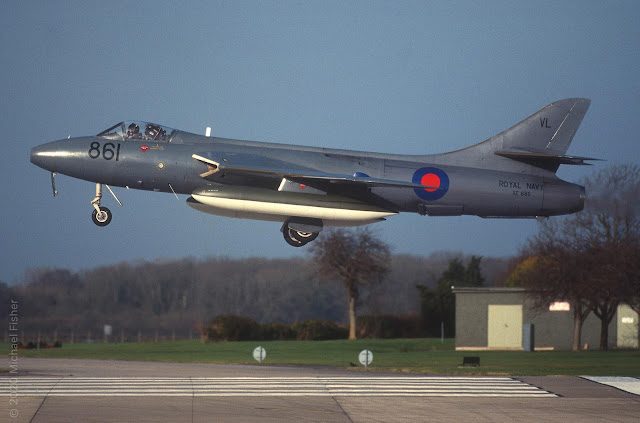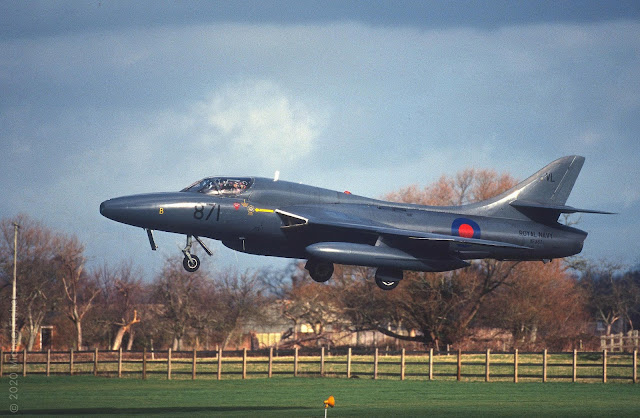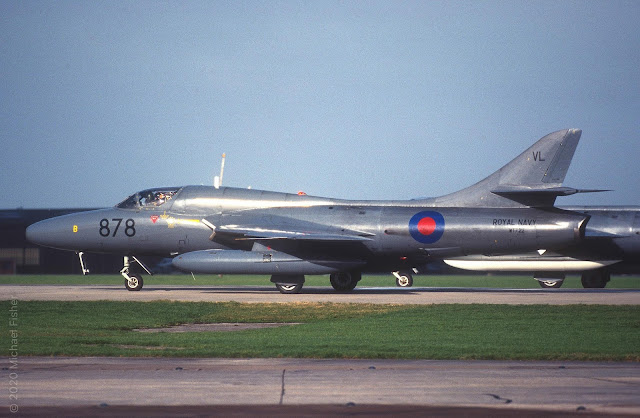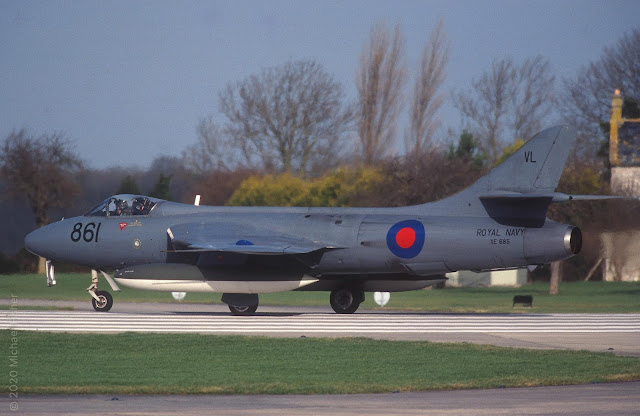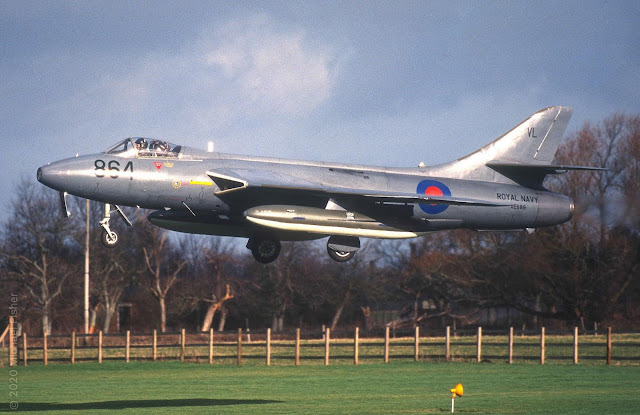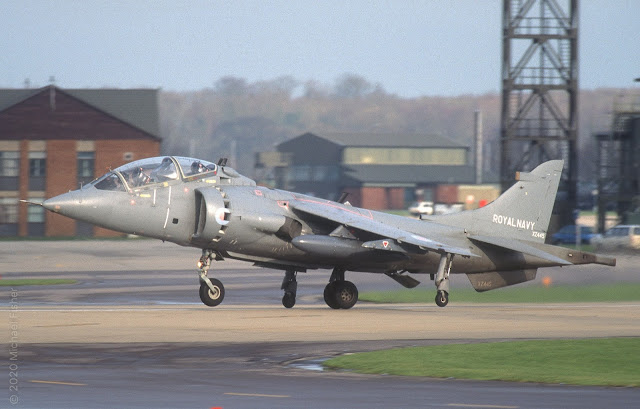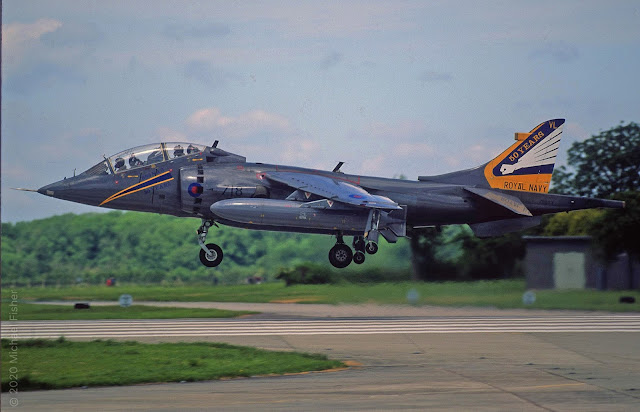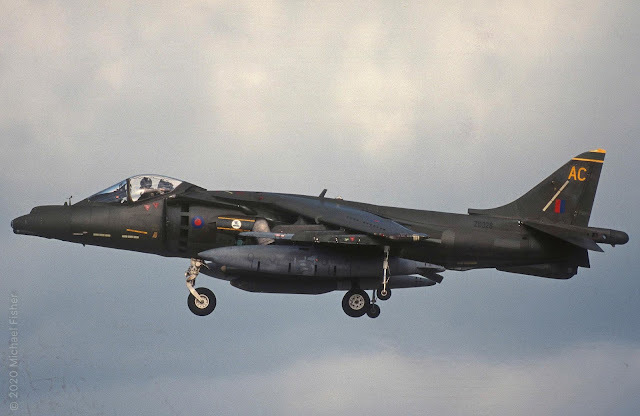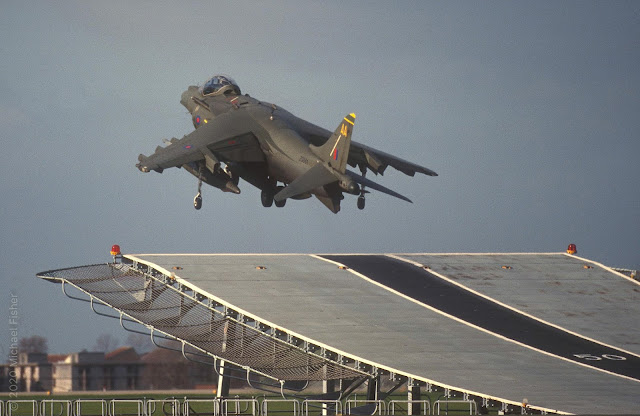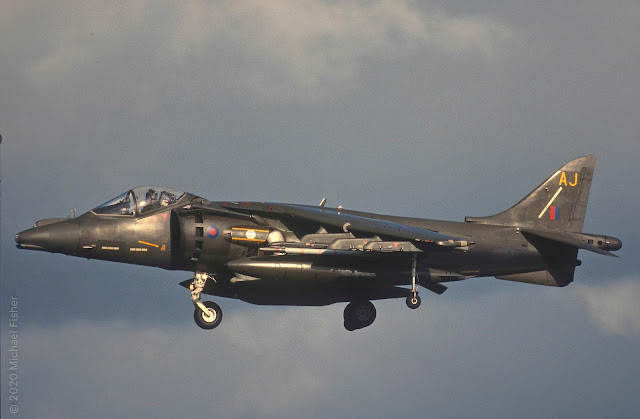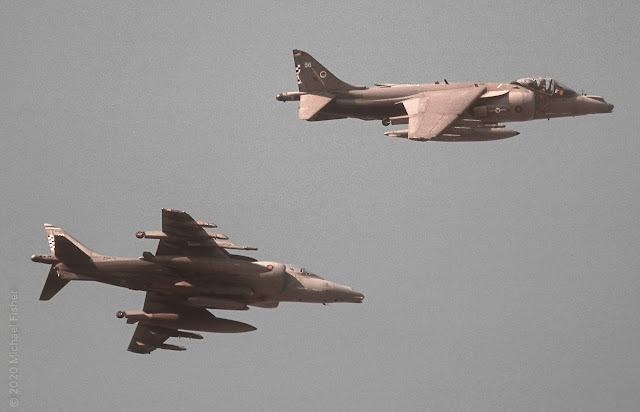I look back in wonder, having found these latest transparencies taken at the Royal Navy Air Station at Yeovilton in Somerset in the early 1990's. They bring back memories of those days when I surreptitiously had to get away from my business for a few hours; RNAS Yeovilton was the ideal ticket as it was a mere forty-five minutes from my home.
The Hunters at Yeovilton were operated by the Fleet Requirement and Air Directions Unit (FRADU) until 1983, when Flight Refuelling Ltd (FRA) at Bournemouth (Hurn) airport won the new operating contract. The Hunters often pitched up at Bournemouth to be serviced by Lovaux. Sadly, by 1994, their days were numbered as the BAe Hawk T.1A came into operational use, and by May of 1995, they were withdrawn.
From April 2000, the Royal Navy's Sea Harriers FA2s were amalgamated with the four serving RAF Harrier GR7/7A squadrons under the new single structure. They were all to be deployable at sea and land. This brought new movements to Yeovilton, with the RAF Harriers using Yeovilton's dummy deck whilst training for their sea-based deployments.
Below are a few of my transparencies captured in the described period, some on Kodachrome 64 and Fuji Velvia. The last one, "Admiral's Barge." was my first digital photo.
Having uncovered even more Yeovilton action, I must post a part two.
For now, let's get on with the action...
ZE695/711 first flew as a Harrier FRS.1 in 1993. It was later converted to an FA.2. It is seen on the approach to RNAS Yeovilton, operated by 899 NAS OEU based at RAF Boscombe Down.
More on the "SHARS" latter.
Let's have a look at a few of the Hunters first.
XE685/861 'VL' Hunter GA.11 RN landing on runway 27 at RNAS Yeovilton. Transferred to the civil register as G-GAII at Exeter.
Later, it was to be seen in a four-ship civilian team known as 'Team Viper' and then purchased by Hawker Hunter Aviation, which is based at RAF Scampton.
XE665/876 'VL' Hunter T.8C was initially constructed as a Hunter F.4 serving with the RAF in Germany. Following conversion to a T.8 at Coventry airport, it went into service with the Royal Navy at RNAS Lossiemouth, passing to Yeovilton and eventually FRADU with a dark sea grey colour scheme.
Sadly, moving to the civilian register as
G-BWGM.
XF357/871 'VL' Hunter T.8C Royal Navy (FRADU).
WV256/862 'VL' Hunter GA.11. Status it became G-BZBP. It can be seen at RAF St Mawgan wearing the marks of 26 Squadron RAF, where it had served at RAF Oldenburg in Germany.
Similar to the Harrier story of not being saleable abroad due to American technology in their canopies, this Hunter was built at Kingstone-Upon-Thames in 1955! It was presented for auction in 1995, forty years after entering service. Amazingly, did it have to be withdrawn from the auction due to American funding for its manufacture?
Eventually, it was sold in 2000 by Phillips in a MOD aircraft auction.
I would be very interested if anybody could shed further light on the financial implications.
WT722/878 'VL' Hunter T.8C. Its status was at the Classic Air Force hanger at RAF St Mawgan, but sadly, its civil registration has been cancelled, and its destiny has yet to be discovered.
XE685/861 'VL' Hunter GA.11 Royal Navy These jets had a history. XE685 was built in Blackpool for the Royal Air Force in 1955. It entered service at RAF Lynham in Wiltshire and later transitioned to RAF Jever in Germany. Following RAF service, it was put into storage.
Acquired by the Royal Navy, it was converted to a GA.11 at Kingston-upon-Thames. It joined Navy service at Lossiemouth, passing to RNAS Brawdy and back to 'Lossie' then to Dunsfold before arriving at Yeovilton. It was scrapped on the 30 March 1994 at a mere 39 years old.
XE689/864 'VL' Hunter GA.11 suffered a fire in France and returned to Hyères airbase in Southern France. Following the incident, the rear fuselage was replaced with that of XE707, allowing it to return to service.
It passed through the Lovaux works at Bournemouth Hurn airport in June 1994 for a major maintenance program and returned to Yeovilton in December 1994.
Sadly, the early retirement program saw Hunter XE689/864 "VL" withdrawn from service the following May 1995. On the 16th of that month, it was flown to RAF Shawbury for storage and, later in July'95, sold to the civilian register.
XZ492/128 Sea Harrier FRS.1 800Sqn late 1993 before passing to RAF St Athen for conversion to an FRS.2.
It was great to see different models of the Sea Harrier operating at Yeovilton and various shades of grey at the time.
It had also served with 801 NAS, providing combat air patrol missions (CAP) and protecting the ships of the British task force during the Falklands conflict. Painted in a dark grey scheme, Argentinian pilots referred to it as ' La Mureta Negra' (The Black Death).
Today, it can be seen in the Fleet Air Arm Museum.
ZD615/723 Sea Harrier F/A2 899 Sqn OCU, recovering to (EGDY).
The Navy's Training Harriers, the T. 4N, had no radar, but pilot training on the radar instrumentation featured in the Harrier FRS1 aircraft was needed. This led to FRADU utilising three Blue Fox-equipped Hunter T8Ms as radar trainers.
XZ445 Sea Harrier T.4A(N), seen here in earlier years, sadly crashed near Wellington, Somerset, in 1996 whilst flying through dense fog with the loss of its pilot and passenger.
ZB803/VL-718 899 NAS adorned with the 50th D-Day Anniversary markings in 1994.
RNAS Yeovilton was chosen as the airbase to host aircraft from 12 nations to celebrate this great event.
See more on that here:- https://legendarymilavia.blogspot.com/2019/05/d-day-50th-anniversary-flypast.html.
From January 1994, the NAS OCU relocated from RAF Boscombe Down back to RNAS Yeovilton, with their Sea Harrier FAS.2 then in service.
The T. 4Ns were upgraded to T.8s, the first of which was delivered in early 1995 and wearing the black colour scheme that would be seen on all the T.8s. They still had no radar, but the instrumentation was improved to a similar specification as the FAS.2 (FA.2).
Above ZD328/AC Harrier GR.7 from 3 Squadron RAF prepares to land before launching from the deck.
Following the commencement of the Joint Force Harrier (JFH) on 1 April 2000, it was only a short time before Royal Air Force Harriers were seen using RNAS Yeovilton's dummy deck for training.
ZG861/AA Harrier GR.7 3 Squadron RAF with 848 Squadron Seaking HC.4 'Junglie' in the background.
ZG861/AA Harrier GR.7 RAF. Lining up in front of the deck.
ZG861/AA Harrier GR.7 airborne off the deck.
ZD410/AJ Harrier GR.7 RAF.
On my visits, the RAF always seemed to arrive with three aircraft.
ZD466/56 and ZD470/60 arriving overhead (EGDY).
A superb lineup, including the RAF T.10 ZH657/105, as you look towards the Fleet Air Arm Memorial Church, known affectionately as
"St Bart's" and the spiritual home of the Fleet air arm.
On Sunny days like the one above, the Southside ramp was more reminiscent of RAF Akrotiri in Cyprus.
ZD470/60 GR.7 RAF preparing for another deck launch.
ZD466/56 Harrier GR.7 with the Joint Harrier Force markings.
ZD466/56 Harrier GR.7 RAF.
ZD470/60 GR.7 RAF follows ZD466/56 airborne.
ZD610/000 Sea Harrier FA.2 'Shar' 899Sqn RN.

ZD610/000 Sea Harrier FA.2 'Shar' 899Sqn RN. Prepares to land for another deck launch.
ZD605/VL-710 FA.2 Sea Harrier 899 Sqn Royal Navy.
ZD578/N-126 FA.2 800Sqn and an 801sqn FA.2 launching before International Air Day.
ZE692/718 FA.2 Sea Harrier and ZH809 FA.2 899Sqn the 'Flying Fist'. The insignia derived from a flying gauntlet.
ZD990/721 T8 Sea Harrier 899Sqn RN practising vertical thrust lifts on a cold winter morning.
ZD993/VL-723 T8 Sea Harrier 899 sqn Royal Navy.
ZD612/718 FA.2 899Sqn Run and break.
ZE696/126 FA.2 800Sqn RN.
ZH803/124 F/A2 800Sqn.
This aircraft has become G-RNFA, owned by Fly Harrier Ltd.
It arrived at RAF St Athen from RNAS Culdrose, where it had been used at the School of Flight Deck Operations (RN SFDO). Maybe one day we will see it fly again?
ZH808/N-003 F/A2 Sea Harrier.
This is just a friendly reminder of those days when a Seaking HC.4 'Junglie' departs and a Lynx HAS.8 can be seen on the ground.
ZH809 FA.2 Sea Harrier 899 Sqn. The 25th Anniversary scheme applied for the 2004 display season to celebrate 25 years of Sea Harrier in Naval service.
As a late-production aircraft, it only flew for 8 years, accumulating 1073 flying hours.
Just a lovely picture.
Farewell, my friends.
If you have reached this far, you may have enjoyed memories of some great days out in Somerset.
Happy Days!

